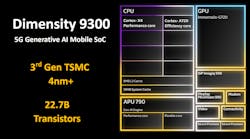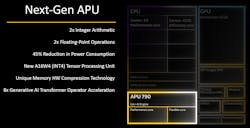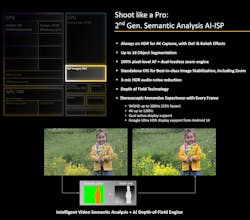Large-Core SoC Targets High-End Mobile Devices
What you’ll learn:
- What applications are the focus of the Dimensity 9300?
- How the platform utilizes AI acceleration.
MediaTek’s Dimensity 9300 is the latest high-performance SoC based on multiple Arm Cortex-X and Cortex-A cores, and it’s complemented with matching artificial-intelligence (AI), GPU, and image-processing cores (Fig. 1). The chip targets flagship smartphones, tablets, and augmented-reality/virtual-reality (AR/VR) devices that require the latest graphics and AI support. It’s built using TSMC’s 4-nm chip process with a thermally optimized design.
The processor complex has a single, ultra-large Arm Cortex-X4 running at 3.25 GHz along with three additional Cortex-X4 cores. Cortex-A720 cores, which are included to help carry the load, were once the high-end complement. The LPDR5T interface runs at 9600 Mb/s and is tied to an 8-MB L3 cache and a 10-MB system cache shared with other cores on the SoC. The system supports UFS 4.0 storage with multi-circular queue (MCQ) support.
The cores integrate the latest Arm support, such as the memory tagging extensions (MTE). These provide improved security and debugging support, specifically use-after-free and buffer-overflow bugs.
Power-Efficient AI
The Dimensity 9300’s seventh AI processing unit (APU) targets generative AI applications (Fig. 2). It delivers 8X the performance of its predecessor for many functions while being more power efficient, thereby reducing power consumption by 45%. It incorporates an INT4/A16W4 tensor processing unit (TPU) along with the company’s hardware-compression technology, which can cut 13 GB of INT8 data down to 5 GB—a 61% reduction.
The AI support can handle up to 33 billion parameters for large-language-model (LLM) AI applications. And it can manage 13 billion parameters using only 16 GB of RAM or process 7 billion parameters at 20 tokens/s. The system includes LoRA model NeuroPilot Fusion capability. The system supports LLMs like Meta’s Llama 2, Baichuan 2, and Baidu AI.
The 12-core Immortalis-G720 GPU has 46% better ray-tracing performance to handle the latest games and graphics (Fig. 3). This includes console-level global illumination effect. The system also doubles the performance of the multi-sample, anti-aliasing (MSAA) support, while delivering a 40% power savings and a 40% memory bandwidth reduction for geometry-heavy games.
Video and Audio Support
Most of the applications targeted by the Dimensity 9300 incorporate one or more high-resolution cameras. These are tied to the ISP Imagiq 950 image signal processor (ISP) that supports always-on, high dynamic range (HDR) operation (Fig. 4). The system incorporates AI support for depth-of-field (DOF) enhancement and a stereoscopic immersive experience. It can handle 4K video at 120 Hz.
The chip supports Google’s Ultra HDR display in Android 14. The ISP uses real-time Bokeh tracking to support Bokeh enhancements as well as 4K AI Noise Reduction (AI-NR). The subsystem also includes three microphones for audio noise reduction.
As the chip is designed for smartphones and connected applications, it features advanced 5G, Wi-Fi 7, and Bluetooth support. The 5G support handles 4CC FR1 Rel. 16 and can deliver up to 7 Gb/s DL in the sub-6-GHz band. It leverages AI for situational awareness to improve connectivity and throughput. On top of that, it’s 10% more power efficient than its predecessor.
The Wi-Fi 7 subsystem delivers up to 6.5-Gb/s throughput. It supports dual-band dual-cell (DBDC) with 320-MHz bandwidth. It incorporates Xtra Range 2.0 technology and multi-link hotspot support. The system uses a Wi-Fi/Bluetooth UItraSave receiver.
MediaTek has some major competition, but the Dimensity 9300 provides an impressive collection of cores to address compute, imaging, AI, and communication in a mobile 5G environment.





